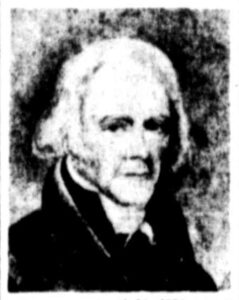[Editor: This article, by A. L. Brient, about Isaac Smith (the first European to land on the east coast of the Australian continent), was published in The Argus (Melbourne, Vic.), 31 July 1948.]
English lad made history
He was the first to step ashore from Captain Cook’s ship in 1770
By A. L. Brien

The Royal Australian Historical Society is bent upon tracing that jewel-box to its ultimate destination. Meanwhile, its existence has deepened the long-held belief that Smith was the first Englishman to set foot on any portion of the east coast of Australia, the first step in the settlement of this fair country, and the subsequent creation of a proud nation.
It was on April 28, 1770 (ship’s log date; calendar date was April 29), that Captain Cook entered what is now Botany Bay, in the barque Endeavour (368 tons), 11 days after he had first sighted Australia near Cape Everard. Anchor was dropped off the south shore at 2pm, and an hour later, with Dr Solander (Swedish scientist), Sir Joseph Banks (English botanist, afterwards to be described as “Patron of Australia”), Cook was rowed to the nearest landing place, a flat rock in deep calm water. His wife’s nephew, young Isaac Smith, AB, was seated in the bow, eager for adventure, for blacks had been sighted, carrying long spears.
The story of what followed, and it was told to Arthur Kitson, Cook’s biographer, by Canon Bennett, second cousin of Mrs Cook, is that when the rock was reached, Cook stood up and called to Smith, “Jump out, Isaac.” It was a feat easy of accomplishment, as I know, because I stood on the selfsame spot early this year, when a memorial recording the event was unveiled by Mr K. R. Cramp, in his capacity of chairman of the Captain Cook’s Landing Place Trust, a dynamic body which has laid out beautiful lawns and picnic grounds, and furnished them with suitable memorials to Cook, Banks, Solander, and poor Forby Sutherland, who died during the Endeavour’s brief stay in the bay. Kendall’s line’s, inspired by Sutherland’s grave, could apply to the whole of the southern shore, now known as Kurnell:
Here tread gently — gently, pilgrim:
Here with thoughtful eyes look round;
Cross thy breast and bless the silence;
Lo, the place is holy ground.
That was written in 1860. What fine flights of fancy might Kendall have indulged in had he stood on the spot today, and looked across the Bay to where the Harbour Bridge rears its colossal height above Sydney’s million and a half people! There was no lack of imagination on the part of Mr Cramp when he said at the unveiling of the Isaac Smith obelisk: “It is within the realm of possibility that Cook’s sojourn in Botany Bay for eight days will be accepted as the most outstanding event in the history of the British Empire.”
Now, Isaac Smith is commemorated among the splendid company of the Endeavour. Unfortunately, very little detail is available about him. We know that he had exceptional skill in “surveying and planning,” because Cook, who made use of his abilities, took him on his second Pacific voyage, by which time Isaac had become a Master’s Mate, although still only 19 years of age. Further rapid promotion, and transference to another ship in the Navy, prevented him from accompanying Cook on his third and last ill-fated Pacific voyage. Smith was to see active service against the French, under the famous Hyde Parker, and as Post-Captain, commanded HMS Perseverance under Cornwallis, in the East Indies. Upon his retirement in 1793, owing to ill-health, he was given the rank of rear-admiral. He inherited Gatehouse, Merton Abbey, so closely associated with Nelson, and died there on July 21, 1831, aged 78 years.
In Cook’s journal of the second Pacific voyage, he refers to the “very accurate charts of all the discoveries we have made, executed by a young man who has been bred to the sea under my care, and who has been a very great assistant to me in this way, both in this and my former voyage.”
That was Isaac Smith. He was also brave. It was no carefree venture to step ashore, knowing that there were aborigines only a few yards away, with poised spears in their hands. In fact, they had thrown others before the boat touched the rock.
The least romantic association with Kurnell, perhaps, is its name — said to have been derived from a corrupted and aboriginal sounding of Connell, name of the first owner of the site, now cherished and guarded as our greatest national memorial.
Source:
The Argus (Melbourne, Vic.), 31 July 1948, p. 7 (The Argus Week-End Magazine supplement)
Also published in:
The Advocate (Devonport, Tas.), 14 August 1948, p. 9 (entitled “Lad made history…”)
The Warwick Daily News (Warwick, Qld.), 16 August 1948, p. 2
The Townsville Daily Bulletin (Townsville, Qld.), 28 August 1948, p. 5
Editor’s notes:
AB = able seaman (a naval rank given to experienced seamen)
Post-Captain = a officer who holds the rank of Captain in the British Royal Navy (distinct from an officer who commands a ship, who may be referred to as “Captain” regardless of rank); the term was not an official rank, but was derived from the fact that official announcements of the appointment of officers to the rank of Captain were “posted” in the government gazette (the term “Post-Captain” is not normally used in modern times)
Solander = Daniel Solander (1733-1782), a Swedish-born naturalist who accompanied Joseph Banks on Cook’s expedition (1768- 1771) to Tahiti and Australasia
See also:
“Isaac Smith (Royal Navy officer)”, Wikipedia
“Isaac Smith”, This is Clapham
“Isaac Smith”, Find a Grave
[Editor: The image used here was sourced from The Townsville Daily Bulletin (28 August 1948) online copy of the article, as it was of a better quality than that in the online copy of The Argus (31 July 1948) version.]
Leave a Reply